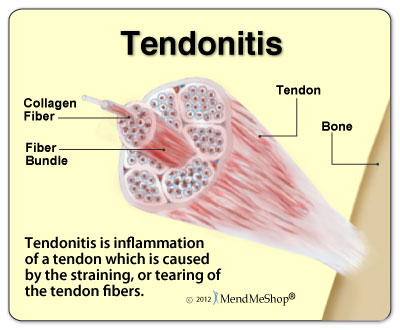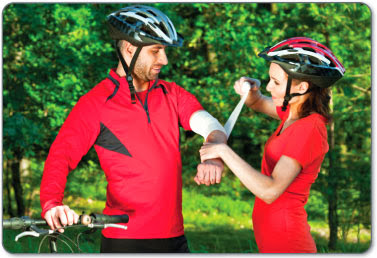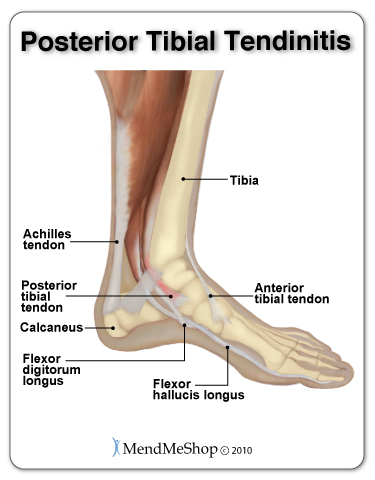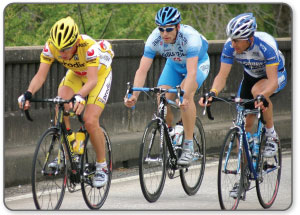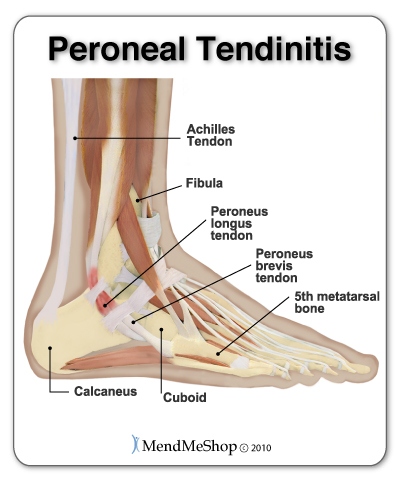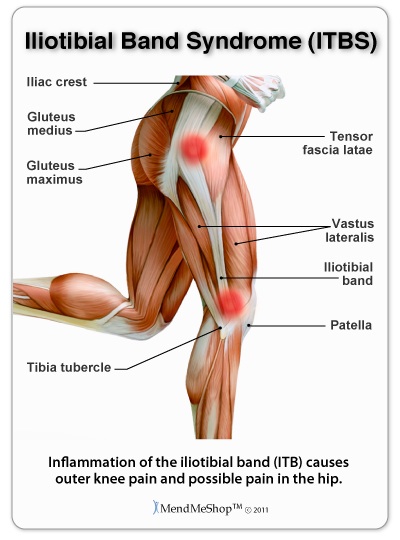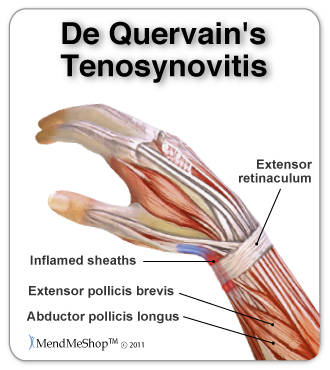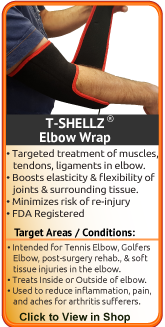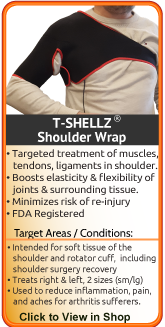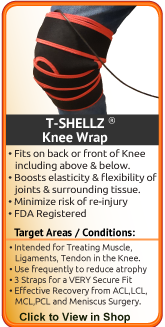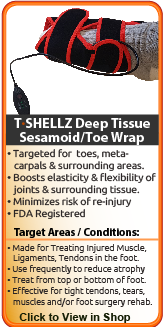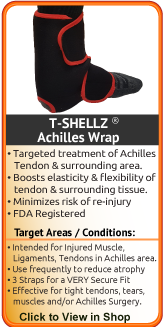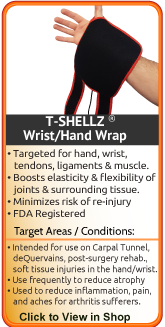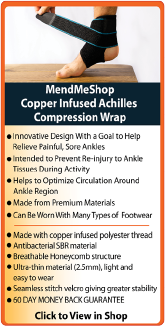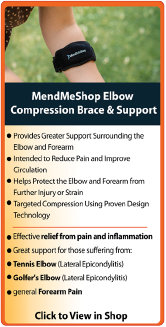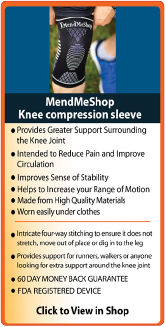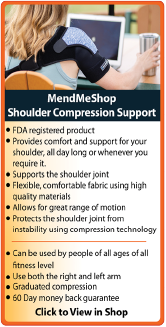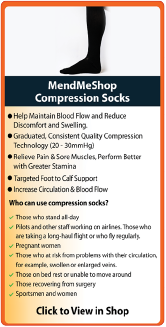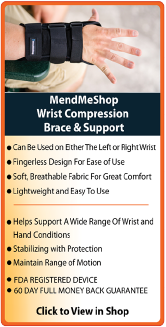What Is Tendonitis?
What Are Tendons?
Tendons are tough, cordlike structures that connect muscles to bones. They are responsible for transmitting muscle force to bone and as such are needed for allowing body movement and overall joint stability.
"Tendons are rich in collagens with the most abundant tendon component being type I collagen, constituting about 60% of the tendon and about 95% of the total collagen. The remaining 5% consist of type III and V collagens. In normal tendons, type III collagen is mainly located in the endotenon and epitenon. However, it is also found in aging tendons and at the insertion sites of highly stressed tendons such as the supraspinatus. Type III collagen forms smaller less well organised fibrils and type I collagen, which may result in decreased mechanical strength."
"Tendon Healing Mechanobiology | Shoulderdoc By Prof. Lennard Funk". 2019. Shoulderdoc.Co.Uk. Accessed May 16 2019. https://www.shoulderdoc.co.uk/article/1029.
Despite the fact that they are ropelike, tendons are actually living tissue; they can and do change properties over time depending on external factors - most physical. With appropriate physical training, tendons will respond by increasing in size and strength. However, if physical training is not done appropriately it leads to overuse injuries which means the tendon will typically undergo inflammation. It is further known by the medical community that lack of use of tendons (immobilisation) will lead to a reduction in stiffness, strength and total weight of the tendon. There have been studies done showing that immobilisation of a tendon will cause uneven and irregular collagen fibres, resulting in a tendon less able to handle high stress loads before breaking down.
What Is Tendonitis?
Tendonitis / tendinitis (pronounced "tendonitus") means you are suffering from a condition where a tendon in your body is injured, inflamed or irritated. There are many tendons in our bodies that are made of fibrous cords of tissue that attach muscles to bones.
Anyone can suffer from tendonitis, but it's most common in adults due to degeneration of tissue as we age. If you have tendonitis you'll usually feel pain located where your injury is and in the surrounding area. If you suffer from a tendon rupture (ruptured tendon) you might hear a sudden pop or experience severe pain immediately after you're injured. Tendon ruptures usually only happen from accidents or pre-disposed conditions that weaken the tendon - like repeated anti-inflammatory injections, calcium deposits (spurs) around a joint or other diseases (ie. gout). Tendon ruptures usually require surgery to re-attach the tendon to the bone, and if left untreated can result in permanent disability of the affected area.
Immediate tendon injury treatment usually consists of avoiding any activity that makes your pain worse (or caused your injury in the first place), resting your injured area, icing the area, and taking non-steroidal anti-inflammatory drugs (NSAIDs) (reference: 1).
Symptoms of Tendinitis
You might be suffering from a Tendon Injury such as Tendonitis if:
- You feel a dull aching pain, especially when moving the affected area or joint.
- There is tenderness around the injured area.
- You have any swelling or inflammation - even on-going swelling over time.
- You are experiencing a loss of strength in the area
- Your injured area is hot to the touch or red.
- You sometimes feel a crackling or grating when moving the injured area.
- You feel a lump along the tendon
- You find it hard to move or notice reduced range of motion - especially if you experience more pain from moving the affected area.
If you're suffering from some of those symptoms and now wondering why your injury is taking so long to heal, it's important for you to know that tendonitis is an inflammatory condition where the pain, swelling and inflammation can go on for weeks or even months.
You could have acute tendonitis (an injury that happened suddenly from an accident or from overuse / repetitive actions) or chronic tendonitis (an injury or re-injury that weeks, months or even years old). Either way your tendonitis injury will have a painful impact on the quality of your life.
At this point your mobility - like your ability to walk, run, jump, carry or pick up object or other activities that you would normally do - is probably impaired... Leaving you with very limited range of motion in the affected area or joint.
Healing your tendonitis can be a difficult task, especially if you're suffering from pain in a general area and have no idea what type of injury you're facing.
Tendon Strain & Re-Injury
Everyone will strain their tendon at least once in their lifetime. Straining your tendon is a common injury but the trick with a strained tendon is to make sure it heals properly which will provide the lowest chance of re-injury.
Re-injury of a strained or stressed tendon happens more easily than the original injury. When your tendon is re-injured there's also usually more inflammation. Tendonitis is a degenerative condition in the tendon fibers that attach muscles to bone. People with tendonitis generally complain of a severe, burning pain in the area, that gradually gets worse and becomes even more painful from stress on the joint.
If you have tendonitis that's from working out or exercising, you should heavily reduce your workout intensity through the healing stage and make sure the injured tendon is warmed up (and cooled down) properly before and after a workouts. When treating tendinitis, rest the area, apply cold compression for 10-20 minutes at a time for at least 3 times a day. Do this to the injured area for the first day up to 3 days.
Grades of Tendon Strain
- Mild tendon strains = The tendon has been stretched or pulled, slightly.
- Moderate tendon strain = Some function will be lost as the tendon has been overstretched and may be slightly torn.
- Severe tendon strains = The tendon is partially or completely ruptured, often disabling the person.
What Kind of Tendonitis Do You Have?
There are many kinds of tendonitis affecting different areas of the body. Some forms of tendonitis include:
Foot Tendonitis
A group of tendons on the top, bottom and along the sides of the foot connect muscles in the leg to the bones in the arch and toes of the foot. A strain to one of the tendons will cause pain in your arch and toes and make it difficult to walk. Posterior Tibial Tendonitis is the most common form of foot tendonitis. These injuries can be caused from over-use, improper stretching or poor form while walking or during any physical activity. Some people with arch issues (ie. that have a flat foot) or arthritis will be at risk of getting tendonitis.
Sesamoiditis is another form of foot tendonitis that's not often thought about. You will know if you have sesamoiditis if you experience most of your pain in the ball of your foot.
Click here to learn more about:
Ankle Tendonitis
With this injury you'll feel pain in your ankle, swelling and your ankle may feel warm to the touch. You might also feel some weakness or instability in your foot and ankle joints. Severe ankle tendonitis (tendinosis) may increase the height of the arch in your foot. The most common form of ankle tendonitis is Peroneal Tendonitis. If left untreated, ankle tendonitis could turn into tendinosis or a complete tendon rupture.
Click here to learn more about:
Leg Tendonitis
One of the major tendons in the leg to get injured is the plantaris tendon. This tendon is in the middle of the calf muscle, on the back of the leg and attached to the Achilles tendon (a major tendon just above the back of your heel). A tear of the plantaris tendon can cause pain in the calf muscle (sometimes described as a stabbing pain) and if the tendon is ruptured there might be a sudden pop. This injury usually occurs during sports or related activities like Tennis. Plantaris tendonitis is also referred to as "tennis leg" or related to tennis leg (calf muscle) injuries.
Knee Tendonitis
Tendons in the knee usually get injured from athletic or sporting activities like rugby, football, volleyball, or any activity involving running and jumping. Individuals with arthritis or osteoarthritis in their knee may also experience knee tendonitis due to the degeneration of bone and tissue in their knee joint. The most common type of knee tendonitis is patellar tendonitis, also sometimes referred to as 'jumper's knee'. If you have knee tendonitis some of the symptoms you'll experience are pain, swelling and inflammation around the injured area. The severity of your pain depends on the amount of damage that's been done to your tendon. Some other common forms of knee tendonitis include quadriceps tendonitis, pes anserine tendonitis, hamstring tendonitis and popliteus tendonitis.
Click here to learn more about:
Hip / Thigh tendonitis
This kind of injury usually happens from overuse of the tendons in the hip and thigh from activities like running, cycling, football, hockey or soccer. If you've suddenly increased your activity level to include exercise, cardio or any other sporting activity then you might be at risk of getting hip or thigh tendonitis. If you suffer from gluteus medius tendonitis you'll probably notice more pain when walking and a weakness in your legs. This type of tendonitis may also be caused by a difference in the length of your legs (leg-length discrepancy).
Other forms of tendonitis - like iliotibial band syndrome (ITBS) or adductor tendonitis - can present pain in different areas. IT Band syndrome may cause pain on the side of your hip that radiate down to your knee (the IT Band is connected to your hip AND knee). Hip alignment issues or regularly running may cause this condition. Adductor tendonitis may transfer pain into your inner thigh. This condition is also usually experienced by individuals who play hockey, football or soccer. For this injury, pain will be felt when stretching or twisting your torso during exercise or athletic activity.
Click here to learn more about:
Wrist / Hand Tendonitis
Tendonitis of the wrist (extensor / flexor tendonitis) usually happens from overuse of the hands and wrists. This can happen from certain jobs that require a lot of hand / wrist movement (ie. assembly line work, tailor, production sewer, mechanic, gardener, painter, office worker, cashier, etc). Although it hasn't been medically proven, tendonitis in the wrist and hand can sometimes be linked to extended use of computer keyboards and other handheld devices (mobile phones, PDAs, gaming systems). With this injury you'll feel pain and swelling in your wrist or hand, and extreme cases may have some nerve damage (carpal tunnel syndrome) with atrophy (wasting away) of the thumb muscle. Other conditions like de Quervain's tendonitis, and thumb tendonitis may mean a thickening of the tissue in your thumb or your pointer finger may be permanently stuck in a bent position (sometimes referred to as 'trigger finger' or 'trigger thumb').
Click here to learn more about:
Forearm Tendonitis
Forearm tendonitis injuries are common injuries and are easily treated with the leg/arm TShellz Wrap®. In such cases pain, swelling and inflammation will be felt in the forearm, usually when holding heavy objects or even just from typing on a keyboard (overuse injury). In all cases, the Arm / Leg Cold Compress or Ice Pack will reduce pain, swelling and inflammation while treatment with the Arm/Leg TShellz Wrap® will increase Blood Flow in the treatment area while also temporarily increasing flexiblity in the same area. Increased flexibility helps minimize risk of further damage, while enhance blood flow provides your body with an increase capability to heal itself, as blood flow is what damage tissue needs to recover.
The best part about the Leg/Arm wraps are their universality. They can be used pretty much anywhere on the arms or leg - wherever there the pain may be.
Arm tendonitis (tricep, bicep)
The triceps tendon is the major tendon of the arm and this tendon connects the triceps muscle to the bony point of the elbow. Full rupture of the tricep tendon in the arm is one of the rarest tendon injuries and can usually only happen after some kind of trauma (accident). If you have tricep tendonitis you'll experience pain, swelling and inflammation around the top of your elbow.
The biceps tendon is in the upper arm attaching at the front of the shoulder. This is more commonly injured than the triceps tendon and is more apt to occur. The distal biceps tendon is on the other end of the biceps muscle and attaches to the forearm just ahead of the inner elbow location. Injuries to both of these tendons is relatively common, especially for those that often handle heavy items. Most at risk are bodybuilders, certain types of athletes that depend on arm strength and heavy manual laborers.
Shoulder tendonitis
Your shoulders are the most mobile joints in your body. The most common forms of shoulder tendonitis include calcific tendonitis, supraspinatus tendonitis (rotator cuff tendonitis) and bicep tendonitis. Calcific tendonitis is a condition where bone (a calcium deposit) has grown in the middle of one of your rotator cuff tendons. The causes of this injury are still a mystery to many medical professionals, but the body can eventually (over time) re-absorb the calcium deposit so it will disappear.
Supraspinatus tendonitis can sometimes happen with shoulder impingement syndrome. Individuals that work in jobs with repeated overhead activity and athletes participating in swimming, tennis and volleyball are most affected by this injury. If you have supraspinatus tendonitis you'll experience pain, swelling and inflammation on the side of your shoulder (around the deltoid muscle).
Much like supraspinatus tendonitis, bicep tendonitis is caused by repetitive overhead activities like swimming, tennis and baseball or even lifting weights. If you have bicep tendonitis you'll experience pain, swelling and inflammation at the front of your shoulder. Bicep tendonitis is a common condition that occurs with other problems in the shoulder joint.
Click here to learn more about:
Tendonitis Treatment -
What You Can Do at Home
Step 1 - Reduce Pain & Swelling
Inflammation is the body's natural response to a soft tissue injury and is a normal part of the healing process - helping to reduce tissue infection in the early stages of injury. Swelling, pain, heat sensation, redness, and loss of function are the main symptoms experienced and it is your bodys way of telling you there is something wrong.
The 1st step for conservative treatment of your tendonitis is to reduce the swelling to "open up" the area for more blood flow. Anyone in the health-care business knows that your blood supplies the oxygen and much needed nutrients required to heal sesamoiditis injuries. This is why for years doctors, trainers and other medical professionals have recommended RICE (Rest, Ice, Compression, Elevation) to treat the pain and swelling of fresh injuries, chronic pain, and after any re-injury.
Cold Compression Slows nerve and tissue function - reducing the swelling that blocks blood vessels from doing their job. This is important because once blood vessels are blocked or damaged, they can no longer carry oxygenated blood through the tissue and tissues begin to break-down. Without cold compression, tissue break-down continues as they don't get the oxygen they need to survive. By limiting the amount of damage done to your tendon, you also limit the amount of healing that needs to occur. This is a very important step to heal tendon injuries faster and with less pain! This is why you need to treat your tendonitis right when you first notice the pain, when you have swelling / inflammation, or directly after a re-injury. Applying a Cold Compress or Ice Pack right away will stop the damage immediately and unblock your blood vessels to let your body's natural blood flow in to start healing the tissue.
Use Cold Compression Ice Packs:
- 24 to 72 hours after your initial injury or when you first notice pain and swelling around your tendon to stop tissue damage at the microscopic level, relieve pain, and decrease swelling.
- After exercise, workouts or activity of any kind to prevent re-injury of your tendonitis.
- Before and after surgery during rehabilitation to control pre and post-surgery pain and swelling.
- Anytime you feel your tendon tissue is tender, painful or you're having a flare-up of an old tendonitis injury.
- Anytime you have swelling, sharp throbbing pain or inflammation.
- Any other situation where you need to draw the pain and inflammation out of your injury.
Step 2 - Improve Circulation to the Area
After the inflammation has been reduced, providing extra blood flow and strengthening the tissue is recommended.
Tendons,ligaments, cartilage, and some muscle fibres are considered dense tissues. As a result, they naturally receive limited blood flow and this is precisely why injuries to these tissues take so long to heal. The challenge is, how do you effectively increase blood flow to these tissues?
- Rigorous exercise is out of the question as it will lead to further injury.
- Physio is helpful, but that only happens a few times a week.

When you have a tendon injury, there is not much blood flow in your injured tendon, especially if it is in the watershed zone, which it probably is. Inflammation and reduced movement (lack of activity or on-going immobility) reduces the flow of blood to an area that is already receiving very little blood flow. If you are moving your injured Achilles around you run a risk of increasing the severity of the injury. If there has been some healing, you could re-injure your tendon all over again.
It is through the blood the body carries the nutrients and oxygen that injured tissues rely on for recovery.. It is well known that increased blood flow helps your body accelerate the healing process.
This is why the TShellz Wrap® is such an important tool. The whole purpose of the wrap is to accelerate blood flow to soft tissue in the treatment area. The end result; you relax the blood vessels within soft tissues of the treatment area. The vessels will naturally expand and allow for more blood flow to reach the very tissues you are trying to heal. In addition, this process will help clear the area of toxins and excess fluid build up, thereby reducing inflammation.
Step 3: Recognize That Healing is a Process
With dedication, the right tools, and the right information - you will achieve your goal of a sustainable recovery. A combination approach of cold, TShellz Wrap® treatments, and functional movements will make it happen much more quickly.
In our experience, soft tissue repair rates via conservative home treatment methods using a dedicated, comprehensive approach have surprised many of our clients, but will differ from person to person. In nearly all cases, however, it is very important to stop whatever you were doing that created the injury in the first place (ie. running, jumping, climbing stairs).
Use Conservative Treatments to Deal with Scar Tissue
It's also important to rest the torn tendon because our natural healing process takes time to heal completely. If you don't rest your torn tendon, your acute tendonitis can quickly turn into a chronic tendonitis injury. To repair our damaged tendon tissue quickly, our bodies will use scar tissue to fill in the tears in the tendon. If you need to rest for an extended period of time and avoid certain activities that make your pain worse, you will be more likely to develop massive amounts of this scar tissue as a temporary healing measure.
Unfortunately, scar tissue will lay down in a messy, complicated way. The scar tissue won't grow straight along with the surrounding healthy tissue in your tendon. Instead this scar tissue will grow all jumbled up in all directions. While scar tissue grows this way it will ultimately lead to long-term stiffening in your tendon, and may even entrap (squeeze on) a nerve, restrict movement, reduce elasticity / flexibility, and cause poor blood flow circulation.
Scar tissue may plague you for weeks, months and maybe even years, depending on your level of activity and the amount of conservative treatments you have done during your rehabilitation. Scar tissue is a major problem, especially when it comes to re-injury of your tendon. When dealing with scar tissue it's always important to:
- listen well to your physician and if conservative treatments are recommended, ask your physician about incorporating the use of a TShellz Wrap® at home. Stick to prescribed treatments daily to ensure you maximize your home recovery opportunity
- frequent use of the Cold Compress or Ice Pack will help reduce swelling very quickly. Much of the pain you feel will be from the swelling, and you might be surprised how fast the pain drops off once the swelling is down.
- Consistent use of the TShellz Wrap will help reduce reinjury risk and promote blood flow to the area (and thereby accelerate the body's own healing process).
- when applied before stretching, the TShellz Wrap® will help elongate connective tissue in the treatment area as well as make it more flexible. This soft tissue will remain elongated for some time after treatment which is why we recommend a TShellz Wrap treatment before undergoing activity/stretching. This means that it helps improve your range of motion while minimizing risk of further strain - this is exactly what you want when trying to recover from tendon and muscle damage.
Our Tendonitis Home Formula Works
It may seem hard to believe, but our Cold Compress or Ice Pack and TShellz Wrap® home treatment products will assist you in recovering from your tendonitis by maximizing blood flow where it's needed most and reducing your swelling and inflammation induced pain.
If you suspect you may have a tendon injury:
- The first thing to do is consult your physician. Only your physician can give you a proper diagnosis and from this, determine a course of proper treatment. Unless you have a rupture, your physician will almost always recommend conservative treatment options - conservative treatment options for an achilles tendon injury typically means rest, ice the injury, elevate the injury and take anti-inflammatory medication.
- Second, if your physician has decided that your injury can be treated with conservative treatment options, then you will find that many of our customers have had great success treating themselves with the TShellz Wrap and accessory products.
- If surgical intervention is required, you will find we have effective solutions for reducing post-surgery inflammation, enhancing range of motion and reducing scar tissue growth. Keep in mind that the TShellz Wrap® should only be used a minimum of 6 weeks after surgery and once you have been assigned home stretching from your doctor or PT - basically not until at least 6 weeks after surgery). Read more about effective options for pre/post knee surgery here.
Tendon Movement and the Re-Injury Cycle
Every time you flex a damaged tendon, you will most like experience significant pain. Once this tissue is injured it becomes very difficult to recover 100% without proper treatment.
Re-Injury of the Tendon Must Be Avoided At All Costs
Constant re-injury needs to be avoided at all costs! Please excuse the obvious statement, but I really need to drive this point home. ReInjury is very common... why? Everyone wants to get back to their regular lifestyle once the pain has reduced. Here is where you have to be careful - often, much of the pain is due to inflammation - so, once you iced the area and the swelling dropped, a lot of the pain probably disappeared too. So then you start back at your regular lifestyle and then all of a sudden the old injury starts flaring up again - this is re-injury!
Just Because The Pain Has Dropped, It Does Not Mean The Underlying Injury Has Healed
Re-Injury is bad because sure, it delays the healing process, but what's worse is that every re-injury and additional healing cycle increases the amount of scar tissue that builds up in the area of your original achilles injury. This applies to muscle, tendons, ligaments and other connective tissue as well.
Scar tissue is a weak form of collagen - hard, inflexible, and tough to get rid of once it begins to take hold. The more scar tissue that develops, the more you lose the range of motion in your ankle. With excess scar tissue build up, the injured tissues and the achilles in general will remain weak and very prone to re-straining and re-tearing.
While you can go a number of days and even a few weeks without any major setbacks during the injury.. inevitably, a certain movement or motion will happen that causes your injured soft tissue to strain and even tear once again. This is attributed to the scar tissue build up and will result in the buildup of yet more scar tissue and a further reduced range of motion (ROM).
The more scar tissue that develops, the greater the risk of winding up permanently injured with chronic pain or arthritis. Scar tissue means that your achilles will not perform as well as it once did and it makes it much more prone to injury later on. The longer the injury remains, the risk of atrophy increases and the risk of more scar tissue increases. The importance of dealing with a tendon injury now rather than later is often underestimated.
Continuous re-injury and build-up of scar tissue makes it more likely that you will wind up with chronic pain, reduced Range of Motion or even arthritis (permanent damage).
An Achilles Tendonitis Injury Does Not Have to Persist For Months Or Longer. Here is Why It Does For Many
Recovery from an achilles injury can take a long time, especially when some of the less effective, traditional methods are utilized. This is simply because many treatments either focus on masking of pain or are too inconsistent to provide sustainable improvement.
1: Visits to Physio (PT) Help - We Always Recommend It - But It Can Be Costly And Inconvenient
While we tout the benefits of PT and believe it to be integral for most sufferers of tendonitis, the problem is that people only attend sessions a few times a week.
To truly provide a long term solution to your tendon strain, you need to be receiving multiple treatments on a daily basis. Not just any type of treatments, but ones that focus on generation of new healthy tissue.
Treatments for tendons are cumulative in nature...meaning the more the treatments are administered, the faster the benefits can be experienced.
Who these days has time to visit a therapist on a daily basis? Not only is your time limited, but the cost of daily PT sessions is out of reach for most people.
Therefore, the focus needs to be on adding treatment options that can be done frequently, from the comfort of your own home (and even the workplace if the opportunity presents itself). We will discuss these options later on down the page.
2: People Tend To Focus Too Much On Cold Treatments
We see it all the time - people for weeks and even months only focus on using cold. Doing too much cold will actually inhibit the recovery because you are starving the injured tissues of the blood flow they need to repair and rebuild the collagen. Cold restricts the vessels - reducing the blood flow to the tissues that truly need it most.
Cold treatments should be more focused on in the earliest stages of an injury with much less focus in the mid and latter stages.
The truth is, there will always some mild inflammation associated with tissue injuries. However, some of that inflammation will remain UNTIL you begin to focus on healing the soft tissue (muscle). Once this begins to heal, the inflammation will then subside more permanently - not just temporarily like with cold treatments.
As an analogy, think of a home with a leaky roof. You can place a bucket on the floor of the attic whenever it rains - and this will help temporarily, but does it truly address the situation? Obviously the answer is no. Not until you focus on repairing the structural issues with the roof - will the problem be actually solved.
The same concept applies to injured soft tissue - you need to focus on reinforcing growth of flexible, strong tissue. To do this, you need more blood flow reaching them, not less.
3: Injections Can Cause Harm If You Are Not Careful
This can be VERY helpful in alleviating pain and in many cases, pain relief alone can make a huge difference. However, some people get a false sense that their injury is healed because they are not experiencing the pain they once did. Some individuals even engage in activities they should not be doing because they "no longer feel pain". Once the effects wear off, people often find their bursitis persists . This of course, results in a prolonged recovery. Be very careful about your activity after the injection because there is little, if any, pain feedback to tell you that you're overdoing it.
Merely masking the pain can be very helpful temporarily, but it is not a solution; it is just a temporary fix.
4: Tendinitis Sufferers Continue to Aggravate & Re-Injure Their Tendon
It goes without saying that anyone suffering from tendonitis or tendinosis should want to minimize their chance of worsening the injury, or re-injuring the tendon once it has started to get better. Obviously, a worsening injury will delay the healing process, but what's worse is that every re-injury and additional healing cycle increases the amount of time that your joint is immobilized. Time not kind to an immobilized joint - you lose strength in the joint but worse than that, you lose the range of motion in your joint via atrophy ( muscles, tendons and ligaments slowly shrink and weaken, decreasing joint elasticity). The more time that goes by with an immobile joint, the more likely you will wind up with a chronic joint problem (long term injury such as tendinosis and/or bursitis). Basically it means that your joint will not perform as well as it once did and it becomes more prone to injury again later on.
TShellz Wrap® = Accelerated Blood Flow
The intention of a TShellz Wrap® is to ease pain by dilating blood vessels, decrease stiffness by elongating soft tissue, improve blood circulation, and boost metabolism and enzyme activity. In stimulating localized blood flow to damaged soft tissue, you provide needed oxygen and nutrients to grow strong healthy collagen. In addition, you will experience a clearing of toxins and excess fluid build up from the injury site. Over the intermediate term, this helps to reduce incidents of swelling as trapped fluids will be whisked away - reducing pressure on blood vessels.
Using the TShellz Wrap® is truly a unique experience. Within moments of applying a treatment, you can feel the healing sensation due to the increase in blood flow within the area. During a treatment, and for quite some time after you finish, the treated area will feel relaxed and warm. It's a very soothing sensation and extremely effective.
Who Should Use the TShellz Wrap®
We recommend the use of a TShellz Wrap®:
- If you are dealing with tendonitis, then a TShellz Wrap® will provide the all-important function of boosting blood circulation in the treatment area (Localized Enhanced Circulatory Response).
- If you are dealing with conditions affecting your range of motion such as tendinosis, tenosynovitis, or even arthritis.
- If you have a chronic tendon condition that has lasted for years- this device is intended to kick start the recovery process to help strengthen the surrounding and supporting tissues. Many of our past clients had suffered for years, then were completely amazed at the results only after a few months of treatments.
- If you are still working with an injured tendon, the TShellz Wrap® will help relax injured soft tissue prior to work and after a day at the job.
- If you are still trying to enjoy your favorite activities such as gardening, hiking, or golf, etc - use the TShellz Wrap® prior to activity to help reduce chances of re-injuring or re-aggravating those targeted tissues.
- If you are suffering from tendonitis and want to treat the major source of it. Through overuse or degenerative changes, soft tissue in the affected area will tighten and constrict. The application of a TShellz Wrap® to the area is intended to relax tendons and muscles, reduce pain and inflammation. It is our position that relaxed and more flexible soft tissue will help reduce risk of further damage.
- If you are experiencing atrophy - this is a treatment we recommend to use on a regular basis, by enhancing blood flow and elongating soft tissue.
- If you have been to a clinic for some form of massage or stretching and your PT or physician has recommended conservative treatments for home.
- If you have a soft tissue injury and need surgery, then you will find the T•Shellz blood circulation boost to be a powerful tool after surgery to help surgically repaired tissues rebuild for long-term health. (once the surgery wound has healed and your physician has given the ok - 6 weeks after surgery minimum)
- If you are experiencing atrophy in the area and want to reduce the chance of re-injury while stretching - this is a perfect treatment to use every time before you stretch.
Increased Blood Circulation Maximized the Body's Ability to Repair Soft Tissue
TShellz Wraps® contain a unique, flexible Carbon Fiber Energy Pad which is flexible and will shape to conform to your body. This Energy Pad emits a uniform wave of perfectly safe energy over its entire surface. This energy is absorbed by soft tissue in the area, resulting in an increase in blood flow. Increased blood circulation is what your body needs to accelerate the healing of soft tissue and this is why we recommend the TShellz Wrap®.
The TShellz Wrap®, is an FDA Registered Medical Device and is suitable for use at home. It is completely safe for people and patients to use for themselves.
The technology found in a TShellz Wrap® has been in use for decades in the worlds of professional and amateur sports - a contributing factor as to why athletes seem to recover from injuries so quickly.
Have you ever wondered by an athlete can return to activity after 3 or 4 weeks following a knee injury - while your average person takes much longer to return back to normal? The secret isn't really that much of a secret - it involves consistent conservative treatments such as the TShellz Wrap® to help stimulate blood flow to injured soft tissue. Most athletes have the luxury of using in-house facilities many times per day.
How many us can afford the time and money to visit a clinic multiple times a day? Very few indeed. This is how you can gain the same advantage that athletes enjoy via quick recovery from soft tissue injuries - by using a device like the TShellz Wrap® two or three times a day on a consistent basis.
Consistent Treatments = Consistent And Long Term Improvement
What Else Makes the TShellz Wrap® So Special?
We believe the TShellz Wrap® to be an effective treatment to stimulate blood flow to soft tissue such as muscles, tendons, ligaments, and other similar tissues.
We can promise that you will receive a product that is designed to be safe and does what it is supposed to do...quickly relieve pain and aid in the recovery from tendon, muscle and other soft tissue injuries via an increase in blood flow.
The unit plugs into a standard wall outlet to get its power. The nice thing about the power supply is that the same unit can be used in North America and overseas as well. It has the capability to operate between 110v and 230v.
It has a special signal controller that can be set for 3 different power levels of application (3=High, 2=Medium, 1=Low). The cord is long so you can sit or lie comfortably and watch TV, read or surf the net while you're using it.
Treatments are max 30 minutes in duration and the device can be worn over clothing. This allows you to use the device at work, at home, or really anywhere you have access to an electrical outlet.
A Recap of the Benefits of the TShellz Wrap®..
- Targeted applications for most areas of the body
- It can be used before exercise to warm up your achilles to reduce the risk of injury
- FDA Registered medical device for use in home or clinics - very high quality
- Increases flexibility of tissues (reducing the re-injury factor)
- It soothes pain and whisks away toxins
- Carbon fiber Energy Pad is strong, lightweight, and flexible - contours very easily
- Enhanced blood flow provides an accelerated healing rate that will save time and money when associated with doctor or PT visits
- A boost in blood flow can accelerate the bodys ability to recover. This can be beneficial in post-surgery rehabilitation, getting you back to work faster
When Should I Use My TShellz Wrap During the Day?
The most common question we receive from individuals prior to purchasing is - how many times a day should I be using my TShellz Wraps® and when should I be using them? While treatment plans will differ for each individual and their specific injury, there are general guidelines that should be adhered to.
- Use a Cold Compress or Ice Pack when you are experiencing inflammation (usually after exertion or movement of the injury area).
The Achilles TShellz Wrap® would then be used:
- Right after rising from bed in the morning (as this is when it is most stiff)
- Prior to going to bed at night (to relax the achilles, allowing for better sleep)
- Before you know you will be using your injured joint (going to work, driving, running, walking, etc).
We Receive Calls All the Time
From Customers Who Simply Want To Thank Us For Introducing Them To Our Amazing Products!
Let me tell you, we appreciate all the feedback we have received over the years. We have had many medical professionals, athletes and everyday people call and write to tell us about their positive experiences with our devices and the company in general. It never gets old hearing about the successes and it provides us with the motivation to continue doing what we do best - provide individuals with options to heal from the comfort of their own home.
Below is a small sample of some of the Customer Service comments we have received from customers...
The Best Service by Far!
The service from the Mend Me Shop is by far the best you could ever hope for. I have spoken to Paul on numerous occasions and his knowledge is very much appreciated.
Do not hesitate to order from this company. Their products are made well and work. Their customer service is the best you could ever hope for.
Charlie, North Carolina, USA
I have called the office and received helpful guidance. Really appreciate the help and so glad I found your products!
D. McBride, USA
I really appreciate y'all emailing and responding. I'm in business myself so I know the importance of customer service. Your company has done a superb job and it's really appreciated. I know it takes a lot of time but it's very well worth the time you spend.
C. Vickers, USA
Thank you, too, for the personal attention to your customers. A rarity, in today's world!
L. Anderson, USA
You guys are tremendous. I was overwhelmed by your speed and thoroughness regarding my problem.
T. Kienlen, USA
Thanks again for your wonderful products and support.
J. Sese, USA
The fact that you guys are there for us every step of the way matters as well. Your company is wonderful and that's a rarity these days.
M. Callahan, USA
The cost seemed minimal compared to what I had already spent at the doctor and PT.
P. King, USA
Thank You so much superior service as well as unprecedented guarantee.
D. Hunzicker, USA
If you're tired of being told that resting, drugs and surgery are the only answers to your achilles injury.... Be optimistic, because there are effective alternatives for you.
The Reasons For Our High Success Rate - Our Customers!
We will never claim our products will work for everyone. That is simply impossible to achieve. Everyone has a different capacity for recovery and different circumstances behind their injuries and/or conditions.
In addition, some people may have a hard time sticking with recommended protocol in order to achieve benefits from our devices. Quite simply, our clients that have had successful outcomes have made a small effort to invest 60 minutes a day into the program. If you do the same, chances are you will be very happy with the outcome. The fact that our very low return rate speaks volumes as to the confidence we have that our products will be effective for you! I mean with a full 60 day money back guarantee on our wraps, there really is no risk in trying.
Right after you place an order, email us and we will have a plan developed immediately so you will be able to get started upon arrival of your parcel. We can't promise you miraculous results, however, we do promise to do everything we can to help you with your condition.
Everything you have read up to now has hopefully given you some hope.
However, words are meaningless unless a company stands strongly behind the products they sell. This is what sets us apart from others...we offer people a comprehensive, 60 day, full 100% money back guarantee. We take on all of the risk because we know our products work well for the overwhelming majority of people who purchase them.
We Stand Behind All Our Promises With An Iron-Clad Guarantee
Guarantee #1
Use your products diligently for up to 60 days and you will experience a significant reduction in pain. If not, I encourage you to send back the items for a no-hassle 100% refund. Guarantee #2
You will not be left in the dark after purchasing any product from us. AidYourTendon Advisors and Product Specialists are available 9:00 am to 5:00 pm Eastern Standard Time Monday to Friday. Guarantee #3
Your order is guaranteed to be shipped within 24 hours on every business day. Guarantee #4
All purchases receive a one year, full replacement warranty with guaranteed, prompt service. Guarantee #5
You could save hundreds of dollars and possibly more, by getting back to work sooner.
We Can Get You Started For Less Than The Cost Of A Few PT Treatments
Overall, we are able to be cost effective and value oriented due to two major reasons:
- Word is spreading and as a result, our sales are increasing. With this increase, we can achieve economies of scale...meaning we receive the best component pricing because our volume is high.
- We keep our overhead costs low by selling only on-line versus setting up costly distribution channels offline.
Think about it – you can now have the ability to treat your pain from the comfort of your own home while saving money in the process.
Best of all, you are fully protected when making a purchase from us as we offer a 60 day, full money back guarantee.
The Next Step Is Up To You!
Living with pain is never easy as it affects your entire lifestyle. Nothing is more important than making the proper decision when it comes to treating your muscle injury. Most methods only mask the problems or provide temporary relief; they do not treat the pain at its source.
AidYourTendon stands out in this regard as our goal is to help you heal for the longer-term.
The bottom line is, you are welcome to try our products for a full 2 months. If you do not receive the benefits that others have experienced, call us to let us know you will return your purchase back to us and we will issue a prompt & full refund. There will be no hard feelings.
The fastest option you have to get our product into your hands as soon as possible is by placing your order online - at this very moment..
Place your order on-line through our ultra-secure
website by clicking the image below:

Or, Call Our Office. We are open Monday to Friday to allow you place an order over the phone. Simply call toll free 1-866-237-9608 to place an order with one of our knowledgeable Product Advisors. They have the ability to answer all your questions...ensuring you only receive the products you need.
North America Toll Free 1-866-237-9608
Outside North America +1-705-532-1671
If you choose to order through our online shop, know that we keep no credit card data on file. Once the transaction is completed, the credit information disappears from our internal systems.
As you can see, ordering from us is a very easy and safe process, no matter if choosing to order on-line or over the phone.
Are you still unsure about placing an order? let me address some questions that may causing some hesitation...
What is the success rate of the TShellz Wraps®? Do they really work?
We try and keep in touch with a large percentage of our customers, and we encourage them to do the same. In doing so, we have received a lot of feedback as we have been in the business since 2008.
We can say that the return rate on our products is only around 5 to 10% any given month. That is exceptional by anyone's standards.
Therefore, we can safely indicate that the overwhelming majority of people who purchase from us do achieve benefits with our products.
How much time do I need to dedicate for treatments? Are the products easy to use?
The TShellz Wraps® are very easy devices to use. After one or two uses, you will engage in the treatments with ease. Very detailed instructions are included and you are always welcome to contact us by phone or email if the need for help arises.
In regards to the TShellz Wrap®, it is ideal to use the device two or three times a day on average. Each treatment session is a maximum of 20 minutes in duration and the device will turn off automatically at that time. Typically, people use the TShellz Wrap® before bed, upon awakening (or not long after) and one other time during the day when the opportunity presents itself. For people in an office setting, many will use the device at work (as it can be worn over clothing). For others, they will use the device an our or two after work.
A Cold Compress or Ice Pack is primarily used following activity that stresses the injured tissues (following work, after a sports activity, or just suffering a general re-injury). This is done to reduce inflammation and to minimize tissue damage. Treatments are 15 to 20 minutes in duration.
How long has MendMeShop been in business
We established our firm in December of 2005. Our track record in this field continues to grow and we plan on being around for many decades to come.
What is your return policy? Is it the standard 30 days?
We go above and beyond what other companies offer - we offer a full 60 day money back guarantee with no restocking fees.

Learn More About Tendon Injuries & TreatmentsI want to learn more about Post-Surgery Recovery I want to learn more about TShellz Wrap® Circulatory Boost I want to learn more about Ice & Heat: Which Is Better For Treatment? I want to learn more about Tendonitis Treatments I want to learn more about Tendonitis Surgery
FREE SHIPPING ON ALL PRODUCTS CURRENTLY ENABLED
60 DAY TRIAL PERIOD
During your recovery, you will probably have to modify and/or eliminate any activities that cause pain or discomfort at the location of your soft tissue injury until the pain and inflammation settle. The more diligent you are with your treatment and rehabilitation, the faster you will see successful results!
| 